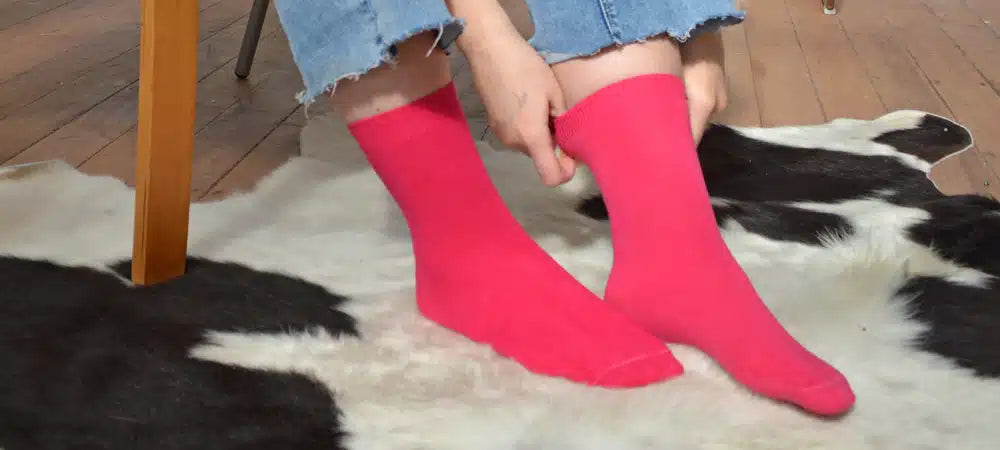Socks are an essential part of our daily wardrobe. They keep our feet warm, protect them from blisters, and prevent them from sweating excessively. With that being said, it is important to know when to replace them to ensure optimal performance and hygiene. So how often should you replace your socks? The answer of how often should I replace my socks varies depending on a few factors. In this blog, we will dive into those factors and help you determine the best time to replace your socks.
Factors that Affect the Lifespan of Socks
Material: The material of your socks plays a big role in determining how long they last. Socks made from natural fibers such as cotton or wool tend to wear out faster than those made from synthetic materials such as polyester or nylon. This is because natural fibers are more susceptible to wear and tear and can also shrink or stretch over time.
Frequency of use: How often you wear your socks will also impact their lifespan. If you wear the same pair of socks every day, they will wear out faster than if you rotate them with other pairs.
Type of activity: The type of activity you engage in while wearing your socks can also affect how long they last. Socks worn during high-intensity activities such as running or hiking may wear out faster than socks worn during low-impact activities such as walking.
Fit: Socks that are too loose or too tight may wear out faster than those that fit properly. When socks are too loose, they can bunch up and rub against your skin, causing friction and wearing out faster. When socks are too tight, they can stretch out and lose their shape, leading to holes or thinning in certain areas.

When to Replace Your Socks
Now that we’ve covered the factors that affect the lifespan of socks, let’s take a look at when you should replace them.
Holes or thinning: If your socks have holes or thinning in certain areas, it’s time to replace them. Holes can be a sign of excessive wear and tear, and thinning can lead to holes in the future.
Discoloration: If your socks have become discolored or stained, it may be time to replace them. Discoloration can be a sign of excessive sweating, which can lead to unpleasant odors and bacterial growth.
Loss of elasticity: If your socks have lost their elasticity and no longer hug your feet, it’s time to replace them. Socks that don’t fit properly can cause friction and lead to blisters.
Bad odor: If your socks have a persistent bad odor even after washing them, it’s time to replace them. The odor may be a sign of bacterial growth, which can lead to foot infections.
Stretching or shrinking: If your socks have stretched out or shrunk, it’s time to replace them. Socks that don’t fit properly can cause discomfort and lead to blisters.

How Often to Replace Your Socks
Now that you know when to replace your socks, let’s take a look at how often you should do so.
Everyday socks: If you wear everyday socks made from natural fibers such as cotton or wool, it’s recommended that you replace them every six months to a year. This is because these materials are more susceptible to wear and tear and can also shrink or stretch over time.
Athletic socks: If you wear socks during high-intensity activities such as running or hiking, it’s recommended that you replace them every three to six months. These types of socks are subjected to more wear and tear than everyday socks and may wear out faster.
Compression socks: If you wear compression socks to improve circulation or for medical reasons, it’s recommended that you replace them every three to six months. Compression socks can lose their elasticity over time, leading to decreased effectiveness.
Dress socks: If you wear dress socks made from natural fibers such as cotton or wool, it’s recommended that you replace them every year to two years. These types of socks are typically worn less frequently and subjected to less wear and tear.
Seasonal socks: If you wear socks specific to certain seasons such as winter or summer, it’s recommended that you replace them every year. Seasonal socks may not be worn as frequently and can be subject to storage conditions that may affect their longevity.

Tips for Maintaining Sock Lifespan
While replacing your socks at the recommended intervals is important, there are also things you can do to extend their lifespan:
Wash your socks in cold water: Washing your socks in hot water can cause shrinkage and damage to natural fibers. It’s recommended that you wash your socks in cold water and air dry them.
Avoid using fabric softener: Fabric softener can coat the fibers in your socks and reduce their ability to wick away moisture, leading to bacterial growth and bad odors.
Rotate your socks: Rotating your socks with other pairs can reduce the frequency of wear and tear and give them time to air out between wears.
Avoid wearing socks for more than one day: Wearing socks for multiple days can lead to bacterial growth and bad odors.
Store your socks properly: Storing your socks in a cool, dry place can help prevent moisture buildup and bacterial growth.

Final Thoughts
Socks are an important part of our daily wardrobe and play a crucial role in keeping our feet healthy and comfortable. Knowing when to replace your socks can ensure optimal performance and hygiene. While the lifespan of socks varies depending on a few factors, replacing them at the recommended intervals and following proper care guidelines can help extend their lifespan. By taking care of your socks, you can keep your feet happy and healthy and hopefully never again have to ask the question ” How often should I replace my socks ? “









